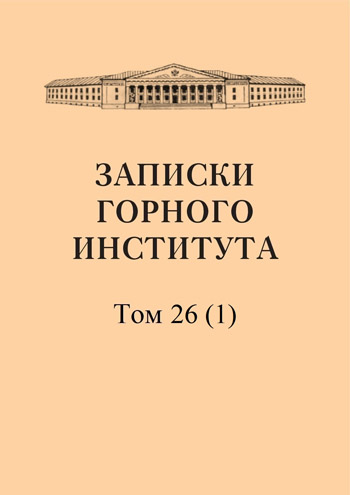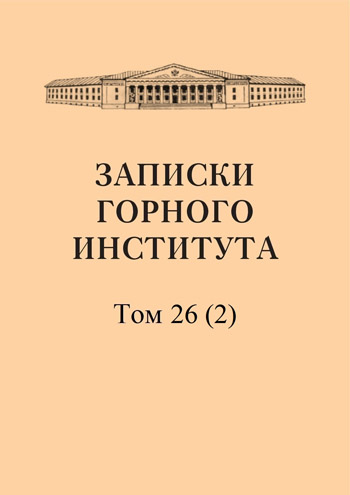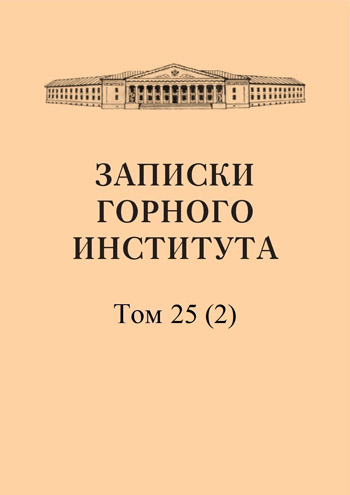-
Date submitted1951-07-28
-
Date accepted1951-09-07
-
Date published1952-03-26
On the issue of dynamic braking as applied to a mine hoist with an asynchronous drive
- Authors:
- F. N. Shklyarskii
In practice, it may be necessary to lower people down a mine shaft at a reduced speed compared to the full speed of lifting the load. This makes it necessary to use braking operations, which in practice are often carried out using a mechanical brake. However, prolonged operation of a mechanical brake is accompanied by undesirable phenomena: excessive heating and wear of the brake pads, which necessitates the use of cooling devices and frequent replacement of worn pads with new ones. Electric braking systems are free from these drawbacks, of which in the case under consideration both counter-current (counter-switching) and dynamic braking can be used. To be able to implement the counter-current mode, the lifting unit must be equipped with a load rheostat, which, compared to an ordinary starting rheostat, must be designed for longer operation. In addition, this rheostat must have additional sections with a correspondingly increased resistance to be able to obtain small braking moments. The main disadvantage of counter-current braking is its uneconomical nature, due to the significant consumption of energy from the network. As is known, the power consumed in the counter-current mode from the network depends on the magnitude of the braking torque and synchronous speed and does not depend on the actual speed of descent. The energy consumed from the network is inversely related to the speed of descent.
-
Date submitted1951-07-01
-
Date accepted1951-09-09
-
Date published1952-03-26
Methodology for assessing the accuracy of mineral reserves calculations
- Authors:
- D. A. Kazakovskii
The currently known methods of calculating reserves cover all cases and specific conditions of various deposits with sufficient completeness. The correct choice of a method from among the existing ones ensures obtaining results with an error, the magnitude of which is determined not so much by the calculation methods as by the detail of exploration. From this point of view, the development of new calculation methods (especially based on preliminary and detailed exploration data) is not a pressing task. It should be borne in mind that from the point of view of accuracy, all calculation methods used in practice are approximately equivalent, with the exception of the arithmetic mean method. Methods for calculating reserves in operational exploration require further development, mainly in the direction of simplifying the calculation technique associated with the use of the numerous data that must be dealt with in these cases. Here, smoothing techniques should be used more widely, as well as methods of mathematical statistics (in particular, correlation theory) to clarify the patterns of mineralization, as well as to delineate ore deposits. Special mining-geometrical graphs should be used more widely, allowing cumbersome calculations to be replaced by comparatively simple graphical operations. In connection with the large number of samples and tested workings, the use of graphs has significantly simplified the calculation of reserves.
-
Date submitted1951-07-18
-
Date accepted1951-09-03
-
Date published1952-03-26
On solutions of one class of linear integro-differential equations
- Authors:
- T. I. Vigranenko
In connection with the study of branching points of nonlinear integro-differential equations, to the solution of which the problem of longitudinal bending of a rod is reduced, N. N. Nazarov proposed to study the integro-differential equation (1) (see article). ... This article proposes a simple method for solving equation (1), which leads to the need to solve one Fredholm integral equation and one algebraic system, the number of unknowns of which does not exceed m (see article).
-
Date submitted1951-07-30
-
Date accepted1951-09-09
-
Date published1952-03-26
Forecast of water breakthroughs from the soil of mine workings
- Authors:
- A. I. Morozov
The development of brown coal deposits in the Moscow Basin is associated with serious difficulties caused by the instability of the host rocks and their high water content. Water content is the cause of peculiar phenomena called breakthroughs. A breakthrough is the release of water or quicksand into mine workings. According to their location and origin, breakthroughs can be divided into two types: 1) breakthroughs from the soil and 2) breakthroughs from the roof. The nature and mechanics of the phenomenon of breakthroughs from the soil and roof are different. A breakthrough from the roof can occur in all cases when, during a roof collapse in a development working or a stope, the above-coal aquifer falls into the collapse zone, regardless of whether it is confined or unconfined. The presence of confined water increases the intensity of the breakthrough and makes it more dangerous in its consequences. For a breakthrough from the floor of a mine working to occur, the presence of a subcoal aquifer is necessary, but still not a sufficient condition. A breakthrough can occur only when the subcoal waters have a pressure that exceeds the level of the workings' soil and are separated from the latter by a low-power impermeable layer. The mechanism of a breakthrough from the soil is reduced to the destruction of the subcoal clay layer that blocks the access of the subcoal aquifer waters to the preparatory or treatment workings. The main active force that destroys the thickness of subcoal clays is the hydrostatic pressure of the subcoal waters.
-
Date submitted1951-07-15
-
Date accepted1951-09-03
-
Date published1952-03-26
Comparative analysis of joint and separate adjustment of two points of mine survey triangulation
- Authors:
- V. G. Zdanovich
The article studies the relationship between the errors in the position of two mine triangulation points rigidly inserted into the existing base network, with their separate and joint adjustment. The solution to this problem is of considerable interest to mine surveying practice when replenishing the existing mine triangulation network with new points as mining operations develop. In this case, when inserting new points, the mine surveyor is forced to accept previously determined points as initial ones, due to which sometimes a significant number of stages in constructing the network arises and its accuracy is reduced to a certain extent. The mine surveyor must be able to quantitatively assess the loss of accuracy of network elements caused by separate adjustment of existing and newly determined points, and on this basis decide on the choice of one or another scheme for inserting points and the most appropriate use of the reference network when solving mine surveying and other engineering problems. If the mine network points are determined simultaneously, then preference, of course, should be given to their joint adjustment, since under normal conditions it always increases the weight to a certain extent elements of the network. But even in this case, the results obtained in the article are of interest, since they shed new light on the issue of the relationship between the weights of network elements in separate and joint equalization of the points being determined and allow a more correct assessment of the merits of the latter.
-
Date submitted1951-07-05
-
Date accepted1951-09-25
-
Date published1952-03-26
Testing of an electric motor with moisture-resistant insulation of a submersible motor-pump with a capacity of Q = 100 m³/hour at a pressure of H = 100 m
- Authors:
- L. F. Shklyarskii
This work was completed in 1950 as a joint venture between the Department of Mining Electrical Engineering of the Leningrad Mining Institute and one of the coal trusts. The electric motor of a submersible motor-pump designed for pumping water from wells in the conditions of the Leningrad coal deposit was tested. Both the pump and the electric motor are completely immersed in water during operation, which significantly distinguishes the design of this motor-pump from all existing ones, in which the electric motor is installed at the top of the wellhead and connected to the pump submerged in water by means of a long shaft (motor-pumps of the ATN type, etc.). The electric motor is made with moisture-resistant insulation of an open type without a hermetic shell.
-
Date submitted1951-07-01
-
Date accepted1951-09-29
-
Date published1952-03-26
Notes on the derivation of formulas for determining the direction error from the eccentricity of the theodolite or signals
- Authors:
- Z. D. Nizguretskii
For assessing the impact of a design error on the accuracy of transmitting directions to a mine, existing mine surveying guidelines usually recommend formula (1) (see article). Using the same reasoning, a well-known formula is usually derived for assessing the accuracy of measuring angles in polygons depending on the impact of signal and instrument eccentricity. The above conclusion does not answer the question: what kind of error should be understood by the value of ex, which in existing guidelines is usually called the "average linear error" [1] or simply "linear error" [2]. Clarification of the meaning of the error ex is absolutely necessary when making practical calculations, since several characteristics of position accuracy are used in error theory, among which the most commonly used are the average linear error of position and the average linear error in direction.
-
Date submitted1951-07-27
-
Date accepted1951-09-05
-
Date published1952-03-26
On the issue of choosing the power and type of the main drive of electric multi-bucket dredges
- Authors:
- L. F. Shklyarskii
Определение мощности главного привода многочерпаковых электрических драг, т. е. привода их черпакового устройства, встречает следующие затруднения. 1. Недостаточная изученность физических свойств грунтов драгируемых россыпей приводит к тому, что усилие резания грунтов черпаками с необходимой степенью точности не может быть определено. Грунты, в основном, не являются однородными. Как следует из классификации грунтов для дражных работ (табл. 1), установленной в 1937 г., грунты могут содержать торф, пески, глины, щебень, песчаник, валуны, изверженные породы и другие компоненты, причем процентный состав их колеблется в широких пределах. Поэтому для подобных грунтов пользоваться физическими константами, полученными при испытании однородных грунтов, будет не совсем правильным. 2. При работе драги могут встречаться различные препятствия (крупные валуны, крепежный лес старых выработок и др.), которые вызывают перегрузки двигателя черпакового устройства. Длительность и величина перегрузок теоретически не могут быть учтены. Выявление характера подобных перегрузок и величины усилия резания может быть осуществлено с помощью нагрузочных диаграмм, снятых самопишущими электрическими измерительными приборами. Выбор типа привода черпакового устройства представляет меньшие затруднения.
-
Date submitted1951-07-29
-
Date accepted1951-09-11
-
Date published1952-03-26
On the initial data for calculating mine heating installations
- Authors:
- L. P. Severin
Heating the air supplied to the mine for ventilation of underground workings in winter ensures uninterrupted operation, improved occupational safety and health protection of workers, extension of the service life of reinforcement and fastening of mine shafts and reduction of expenses for their repair. The requirement for mandatory heating of ventilation air in the mines of the Ministry of Coal Industry of the USSR in winter was first included in the "Rules for the Technical Operation of Coal Mines" (abbreviated PTE) in 1941. § 840 of the PTE states: ""For shafts with an incoming stream, there must be heating (non-fire) devices that ensure maintaining the air temperature below the junction of the heater channel with the shaft of at least +2°." Before the issuance of the PTE, the need to heat the air supplied to mine workings was not mandatory. In 1948, the need for mandatory air heating was included in the Mintsvetmet PTE in a slightly different version. In modern mine heating units, it is common to heat only part of the ventilation air to a temperature of 60-100° C. The air heated to this temperature is directed by a special fan through the heating channel into the mine shaft, where the heated air is mixed with the main flow of cold air coming from the earth's surface through the mouth of the shaft.
-
Date submitted1951-07-10
-
Date accepted1951-09-12
-
Date published1952-03-26
On the issue of protecting structures from the harmful effects of underground mining in coal and shale deposits with an unexplored nature of rock movement
- Authors:
- D. A. Kazakovskii
Until now, at newly developed deposits and at operating deposits with an unexplored nature of rock movement, the calculation of safety pillars in accordance with the recommendation of the "Rules for the Technical Operation of Mines" was carried out by analogy with other more or less studied deposits. However, there were no instructions on the selection of analog deposits, which could not but lead to an incorrect choice of parameters for calculating safety pillars. At present, it seems possible to give some guidelines on the selection of analog deposits based on accumulated factual data. These instructions can be used in calculating pillars during the design of mines and at operating deposits with an unexplored nature of rock movement. They can also be useful in calculating the profile lines of observation stations.
-
Date submitted1951-07-15
-
Date accepted1951-09-08
-
Date published1952-03-26
Taking into account the influence of errors of initial points when assessing the accuracy of mine survey triangulation networks
- Authors:
- V. G. Zdanovich
When using formulas of the theory of errors and the method of least squares for assessing the accuracy of triangulation networks, it is necessary to strive for the most complete consideration of all sources of errors that affect the accuracy of determining the elements of the network. This applies primarily to the influence of errors in the initial data, the issue of taking into account which has repeatedly attracted the attention of geodesists and mine surveyors. In the existing works devoted to this issue, the most detailed solution is based on the direct application of the main formula of the theory of errors to the function of interest to us, which is preliminarily expressed through directly measured quantities (see article). The strict formulas given in the mentioned works, however, are difficult to apply to the analysis of the accuracy of mine survey triangulations, which are usually rigid networks of the lowest construction queues and have a significant amount of initial data. The use of these formulas is associated with the production of very cumbersome calculations that do not have sufficient clarity and hide from the calculator the mechanism of accumulation of errors in the network, thereby complicating the transition to approximate methods of assessing accuracy. To solve some specific problems of assessing the accuracy of network elements encountered in mine surveying practice, it is possible to derive special formulas that solve these problems much more simply and clearly.
-
Date submitted1951-07-25
-
Date accepted1951-09-17
-
Date published1952-03-26
Stress distribution in the rim of a rapidly rotating flywheel
- Authors:
- A. F. Zakharevich
Neglecting the influence of the spokes, we will consider the flywheel as a ring with a circular meridional cross-section (Fig. 1). Let r1 be the cross-section radius; r2 be the radius of the circle containing the cross-section centers. We will take the oz axis as the axis of rotation and assume that the angular velocity is constant and sufficiently large. Using the kinetostatic method, we will apply an inertial force to each element of the rod and determine its elastic equilibrium. To simplify the boundary conditions, we will move to bipolar coordinates.
-
Date submitted1951-07-10
-
Date accepted1951-09-13
-
Date published1952-03-26
Determination of stresses in a gear disk under transverse bending with an axisymmetric load
- Authors:
- L. S. Burstein
The need to study stresses in gear disks arises when the wheel is subjected to axial forces during operation. In this case, we are dealing with a plane stress state, characterized by the magnitude of radial and tangential stresses at various points along the radius of the disk. Experimental study of stresses in a disk under static loading of a real sample is possible if the wheel's own weight is used as a load. As a support surface, one can use: 1) the end plane of the rim, loading the disks with the weight of the shaft and partially with the own weight of the disks; 2) the plane of the flange, loading the disks with the weight of the rim and partially with the own weight of the disks. The first position occurs when the wheel is freely supported on the rim, the second - when the wheel is suspended by the shaft.


